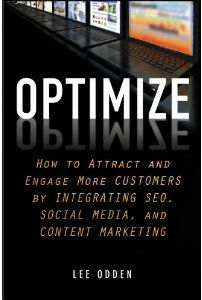 Content is king. And one of the industry's leading pioneers in integrated content strategy is Lee Odden, CEO of TopRank Marketing and author of the new book, Optimize: How to Attract and Engage More Customers by Integrating SEO, Social Media, and Content Marketing.
Content is king. And one of the industry's leading pioneers in integrated content strategy is Lee Odden, CEO of TopRank Marketing and author of the new book, Optimize: How to Attract and Engage More Customers by Integrating SEO, Social Media, and Content Marketing.
We're thrilled that he's joining us this Wednesday for the FREE webinar, Optimize and Socialize for Better Content Marketing, so in advance of the webinar, I picked Lee's brain on blogging, lead generation, SEO, and more. Here's what he had to say:
1. What is the biggest mistake marketers make when developing a content marketing strategy?
Imagine you've started a new company selling software to other companies. You're excited about the product and you know it inside and out. Knowing that the product is a new solution in the category, the need to educate and nurture prospects with content seems the right approach.
So you list off all the features and benefits of the product, research relevant and popular keywords and go about creating the kinds of content that makes the most sense to you: product pages, landing pages, emails, press releases, case studies, even a demo video and webinars . Sound about right? It's a BIG mistake that companies are making every day.
What's missing in this situation is the customer. That's the biggest mistake marketers make when developing content marketing strategy. Who are your customers? Why would they buy your software? What are their goals and pain points. What problems does your software solve for them and what kind of information do your ideal customers need throughout the sales cycle? Also, who are your worst customers? Do you really want to optimize and socialize with content to attract them?
A customer centric approach is central to the message in Optimize and it helps readers do the homework of identifying ideal customers and then turn that insight into a content plan that emphasizes SEO and Social Media marketing tactics.
 2. Should all companies blog? Why or why not?
2. Should all companies blog? Why or why not?
The success we've had and that many of our clients have had moves me to say that any company can become more successful through blogging. But the truth is, without making a commitment in resources, staff and a cycle of listening, engagement and creation, business blogging will rarely work.
Blogging is just a tool and tools are only as good as the expertise of the people using them. Companies that have unrealistic expectations about what blogging will do for them and that approach it with chest beating and self interest are not going to attract and engage a community.
Blogging works for businesses willing to put in the work. At Online Marketing Blog, I've been blogging for over 8 years. By sticking to it and continuously adapting our approach to meet both readers and our agency's goals, we've been able to turn an experiment in curating news into one of the most popular marketing blogs on the web. How many agencies can say that?
3. How can marketers tie blogging back to lead gen and revenue?
Measuring the success of a business blog is no different than any other online marketing effort. It starts with setting goals. The business value from blogging extends beyond lead generation and sales, although those are certainly the first order of the day for most companies. Blogging is a communications channel that can work in concert with other communications to add value, reduce or deflect cost, increase efficiency and effectiveness.
Because blogging is so dynamic and works best as a component of an overall content marketing strategy, it's important to develop a hypothesis about what you expect will happen form a successful blogging effort. What does success look like? How will you know you've met ROI expectations with blogging? Answering those questions will be key in setting specific goals.
With goals, timeframe and a blogging strategy in place, then monitoring of KPIs and measurement of performance can be put in place. If goals are customer acquisition, then it makes sense to map the steps a prospect might take during the sales cycle from awareness to purchase and determine what's measurable about that journey.
Key performance indicators can range from rankings to traffic to social shares and referrals from the media and other blogs or websites. Tracking the quantity and rate over time of KPIs should serve as an indicator that your blogging efforts are moving in the right direction to achieve business outcomes like micro conversions (RSS subscribers, email newsletter signups, demo sign ups, white paper downloads, etc) as well as referrals from the blog to pages designed to sell on the company site. Any leads generated there can be attributed to the source of the referral. Of course any contacts or inquiries made directly on the blog count as well.
Blogging promoted through social networks means tracking network size and rate of growth as well as engagement. A blog post can travel far through RSS, tweets, Facebook and LinkedIn shares, links from other blogs and of course the potential effect of Google+ shares. Visibility on social networks may not create leads directly, but the touchpoint through social when added to search visibility, email marketing, ads and media coverage all add up to building trust in prospects about your brand. That trust shortens sales cycles, increases order size, improves retention and many other trackable business outcomes.
Not to be redundant, but I dig into this quite a bit in Optimize, so readers should get that and really get the goods.
4. What are some of the biggest challenges marketers face when developing an integrated content strategy? How can they overcome them?
When SEO is owned by marketing and public relations runs social media and content creation is shared across multiple departments, integration of those tactics across a company's content efforts can be a challenge. What brings things together are:
- Leadership support through common goals
- Identification of how an integrated approach will help each individual group as well as the company overall
- Training, process and tools/technology to enable integration of tactics
Find the low hanging fruit for an integration project and share the results upstream and horizontally. Make sure that as different departments work together to integrate Social, SEO and content (as well as other online marketing tactics where appropriate) that there is a feedback mechanism in place for those involved to see that they are having an impact. Even if it's not specific to them, showing a trend line of how something like website traffic, or share of voice or leads and sales have improved during the time integration best practices are in place can be very motivating.
5. What is the most important piece of advice you can give to marketers that need to drive more traffic?
I'd ask why more traffic? More traffic = more what? Sales? How many sales? Over what period of time? I think you get where I'm going. Identifying specific goals is the first step towards a plan towards reaching them. That might be more traffic. It might be more of the right traffic. I'd take 100 leads from 1,000 visitors over the work it would take to attract 100 leads from 100,000 visitors any day.